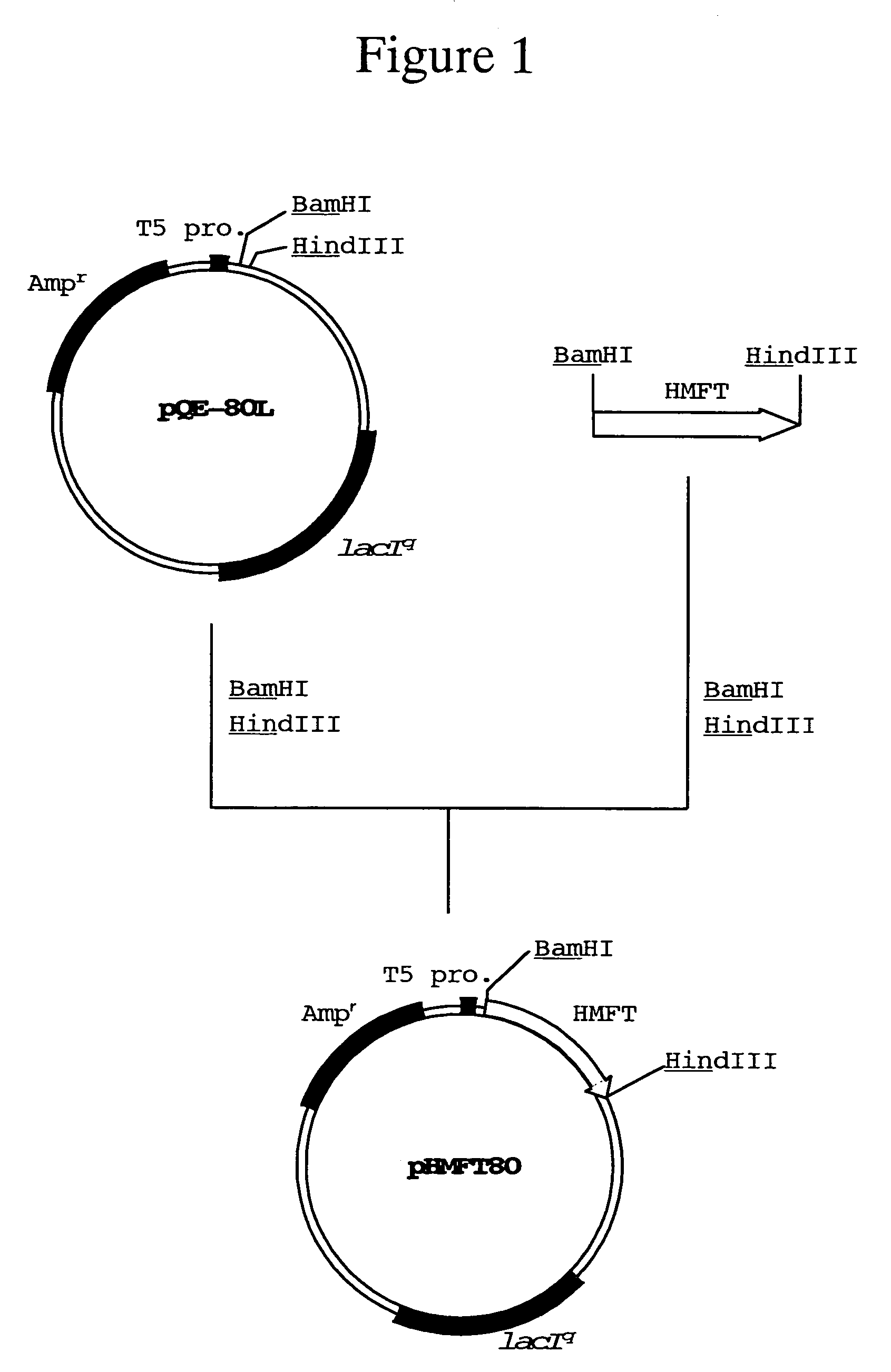alpha1,2-fucosyltransferase and DNA encoding the same
a technology of 1,2-fucosyltransferase and dna coding, which is applied in the field of protein having 1, 2-fucosyltransferase activity, can solve the problem of no example in which an animal-derived 1,2-fucosyltransferase gene was expressed, and achieve the effect of efficient cultur
- Summary
- Abstract
- Description
- Claims
- Application Information
AI Technical Summary
Benefits of technology
Problems solved by technology
Method used
Image
Examples
example 1
Preparation of Probe
[0151]Helicobacter mustelae ATCC 43772 was cultured by a known method [Mol. Microbiol., 20, 833 (1996)].
[0152]After the culturing, a chromosomal DNA of the microorganism was isolated and purified by a method described in Current Protocols in Molecular Biology.
[0153]Using the DNAs respectively comprising the nucleotide sequences represented by SEQ ID NOs:3 and 4 which had been synthesized using DNA synthesizer 8905 manufactured by Perceptive Biosystems, partial fragments of α1,2-fucosyltransferase gene derived from Helicobacter mustelae ATCC 43772 were amplified by PCR.
[0154]PCR was carried out using 40 μl of a reaction solution containing 0.5 μmol / l of each of the above synthesized DNAs as a primer, 0.1 μg of chromosomal DNA of Helicobacter mustelae ATCC 43772, 2.5 units of Pfu DNA polymerase (manufactured by Stratagene), 4 μl of a 10× buffer for Pfu DNA polymerase and 200 μmol / l each of deoxyNTPs and repeating 30 times of a reaction step consisting of 1 minute ...
example 2
Southern Hybridization
[0159]The chromosomal DNA (10 μg) obtained in Example 1 was completely digested with the restriction enzymes BamHI and SacI. Then, 1 μg of the digested fragment was subjected to agarose gel electrophoresis, and after the electrophoresis, the DNA was transferred to a nylon membrane (Hybond N+, manufactured by Amersham Pharmacia Biotech) according to a conventional method.
[0160]Hybridization was carried out using DIG DNA labeling and detection Kit (manufactured by Roche Diagnostics) as follows. The nylon membrane on which DNA was transferred was subjected to prehybridization at 68° C. for 1 hour using a prehybridization solution [containing 0.75 mol / l NaCl, 75 mmol / l tri-sodium citrate dehydrate, 1% blocking reagent, 0.1% N-lauroyl sarcosine, 0.02% SDS(w / v)] in an amount of 2 ml per 10 cm2 membrane. Then, the membrane was subjected to hybridization at 68° C. for 16 hours using a hybridization solution in an amount of 2.5 ml per 100 cm2 membrane, said hybridizatio...
example 3
Colony Hybridization
[0163]Chromosomal DNA (1 μg) derived from Helicobacter mustelae ATCC43772 was completely digested with the restriction enzyme BamHI and SacI, and the digested fragment was subjected to agarose gel electrophoresis, and then a DNA fragment of about 2.4 kb was recovered using Gene Clean II Kit (available from Funakoshi). The plasmid vector pBluescript II SK(+) (0.1 μg, manufactured by Stratagene) was completely digested with BamHI and SacI, and then subjected to dephosporylation with alkaline phosphatase (manufactuered by Takara Shuzo). Then ligation reaction was carried out at 16° C. for 16 hours using the above obtained DNA fragment of 2.4 kb and pBluescript SK(+) obtained by digesting with BamHI and SacI and then by subjecting to phosphatase treatment as described above. Using the resulting ligation reaction solution, Escherichia coli DH 5α was transformed according to the known method described above. The obtained transformants were spread on LB agar medium cont...
PUM
| Property | Measurement | Unit |
|---|---|---|
| Temperature | aaaaa | aaaaa |
| Fraction | aaaaa | aaaaa |
| Fraction | aaaaa | aaaaa |
Abstract
Description
Claims
Application Information
 Login to View More
Login to View More - R&D
- Intellectual Property
- Life Sciences
- Materials
- Tech Scout
- Unparalleled Data Quality
- Higher Quality Content
- 60% Fewer Hallucinations
Browse by: Latest US Patents, China's latest patents, Technical Efficacy Thesaurus, Application Domain, Technology Topic, Popular Technical Reports.
© 2025 PatSnap. All rights reserved.Legal|Privacy policy|Modern Slavery Act Transparency Statement|Sitemap|About US| Contact US: help@patsnap.com

